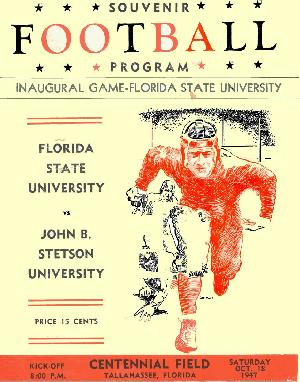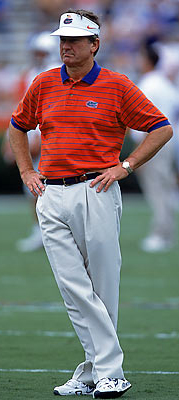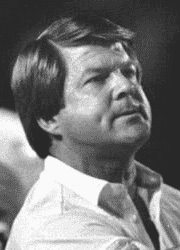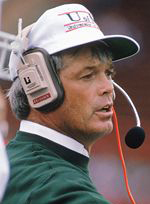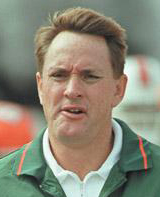Memorable Game: 10/18/1947: Tallahassee FL – Birth of the Seminoles
Enthusiasm was high for the first game.
- The football was painted white for the night game.
- Uniform colors of the
home team were garnet and gold, the colors inherited from the Florida
State College for Women.
- 3,000 fans watched the practice scrimmage.
- Then 7,165 jammed Centennial
Field for the game against Stetson University
to cheer the team that would eventually be called the Seminoles.
Strictly speaking, it was not the first college game in Tallahassee.
- You have to count
the teams from 1899-1904 when the school was called West Florida
Seminary, then Florida State College (1901).
- In 1902, 1903, and 1905 the team was declared state champions.
- Opponents
included Georgia Tech
and the Florida Agricultural College
in Lake City (predecessor of the university in Gainesville).
- However,
the Florida Legislature passed a bill in 1905 making the coed Florida
State College the Florida Female College (later
renamed the Florida State College for Women). All male
students were transferred to the newly created University
of Florida.
- Ironically, the last game the FSC
football team played was a 19-6 victory over Stetson,
the first opponent of the rejuvenated team 43 years later.
Returning GIs from World War II put pressure on the university system.
- The legislature
responded by renaming the Florida State College for Women
the Florida State University and making it coed again.
- The leader of the movement to establish a football team was a student, Ken MacLean. He had played football at Florida
where his 90y run as a 17-year-old freshman HB in 1944 against
Georgia still stands as a school record.
- After
a stint in the military, he re-enrolled at Florida
but missed his hometown near Tallahassee. So he and some of his friends
transferred to the new FSU.
- They approached Dr.
Howard Danforth, Director of PE and Recreation, about starting
a team. Ed Williamson volunteered to coach with assistance
from gymnastics coach Jack Haskins. (Haskins
also created the famous FSU Flying Circus that same
year.)
- The coaches received no extra pay and no football scholarships
were awarded. "We did get an extra carton of milk in the cafeteria
line," MacLean recalled. The coaches put together
a five-game schedule for their makeshift 45-player squad.
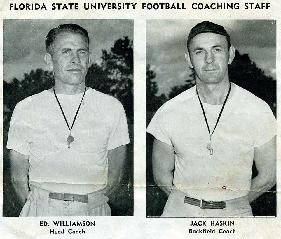
L: Head coach Ed Williamson; R: Assistant Jack Haskins
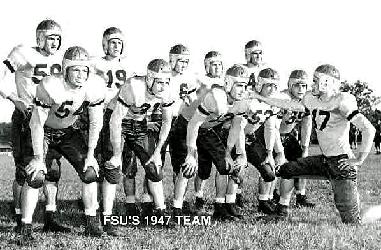
|
|
FSU
scored first against Stetson
on a Don Grant touchdown pass but lost 14-6.
- The team lost
all five games that season (Cumberland 6-0, Tennessee Tech 27-6, Troy State 36-6, and Jacksonville State 7-0).
- McLean led
the team in rushing, punting, and receiving for two years. In the 1960s,
he became freshman football coach under Bill Peterson
and eventually Assistant Athletic Director.
A week after the first game, the student body held a contest to choose
a nickname.
- The winning entrant won a $25 wristwatch.
- Seminoles
was chosen from a list that included Crackers, Statesmen, Fighting Warriors,
and Tarpons.
- Suggestions that didn't make the cut included Swamp Rats,
Pollywogs, Galloping Gophers, and the Red Tide.
The following year, FSU hired a "real" coach,
Don Veller.
- Under his leadership, the 'Noles
won the Dixie Conference each of the next three years.
- Veller
compiled a 31-12-1 record, including an 8-0 campaign in 1950.
- He gave way to Tom Nugent in 1953 as FSU
started playing stronger schedules.
- Nugent's second
team played in the Sun Bowl.
On October 18, 1997, Maggie Strum Allessee, the cheerleader
captain 50 years earlier, led the same cheer at a pep rally in the same
uniform she wore that opening night.
Reference: Report to Seminole Boosters, December 2007
Dedication of Doak Campbell Stadium

|
On October 7, 1950, Florida State University dedicated its new stadium, named in honor of the president of the university at the time. Seating 15,000, the stadium was built at a cost of $250,000. The Seminoles defeated Randolph-Macon College from Ashland VA 40-7 before a crowd of 9,676. The completed west stands were filled to capacity. However, the east stands were not finished, forcing latecomers to stand at the edge of the field.
A week later, the Florida Times Union reported, "Florida State University's Seminoles wore down a surprisingly tough band of Howard College Bulldogs here tonight and scored a 20-6 Dixie Conference victory over the Alabama eleven before a crowd of 5,537 in Doak S. Campbell Stadium." Located in Birmingham, Howard has been known as Samford University since 1965.
Doak Campbell Stadium on Opening Day
Note the light stanchions in front of the bleachers. |
This second game at Doak Campbell is interesting because of the sophomore quarterback for the visiting Howard eleven. It was none other than Bobby Bowden! Two years later, Bobby received Little All-America honors.
He returned to his hometown and alma mater as head coach in 1959, bringing scholarship football back to the campus after an 18-year lapse. He compiled a 31-6 record in four years before leaving to become wide receivers coach at Florida State under Bill Peterson for three seasons. He then became an assistant at West Virginia before taking the head job there in 1970.
Side note: Bobby's 31 victories at Howard are counted in his career total even though they were not achieved at a Division IA school. If that had not been done, Joe Paterno would have the all-time victory record locked up, and both coaches could have retired years ago.
|
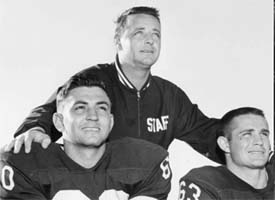
Bobby Bowden, Samford Head Coach
|
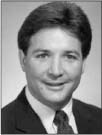
Terry Bowden
|
Bobby's son Terry also coached Samford from 1987-1992 before leaving for Auburn. Terry's first quarterback was Jimbo Fisher, who transferred from Salem College (WV) with his head coach. Fisher set several single game and season passing records in his one year at Samford. He then joined Terry's staff as an assistant from 1988-1992 before moving with Terry to Auburn as quarterback coach. Jimbo is now Bobby's offensive coordinator and designated successor at FSU.
There is a final link in this Howard-FSU connection. Florida State has scheduled a game with Samford at Bobby Bowden Field at Doak Campbell Stadium in 2010. That will be the last year of Fisher's three-year contract that specifies that he must be named head coach at the end of that season. So is scheduling Samford a clue that Bobby has set 2010 as his swansong?
|

Jimbo Fisher |
Memorable Game: September 23, 1967: Legion Field, Birmingham AL
Bear Was Fit to be Tied
Alabama had allowed only 37 points in the entire 1966 season. Little did they know that, when the Tide hosted Florida State in their 1967 opener, the Seminoles would score that many in one game – and still not win!
- Coach Bill Peterson's Seminoles were decided underdogs after their 33-13 loss at Houston the week before. "We had so much adversity going into the game," Peterson recalled. "We had just been blown out at Houston. We changed quarterbacks, and we changed centers. Ken Hart had started the Houston game at center - a great athlete, but there was some trouble with the snap, and we moved him to guard. We put Ted Mosley in there at center, and he came up with a 103-degree fever. We put him in ice to keep it down. And he played a simply great game."
- 1966 had produced a 6-5 record ending with
a 28-20 loss to Wyoming in the Sun Bowl.
- The Tide, on the other hand, had run the table
in 1966, 11-0. However, they finished #3 after the infamous Notre Dame-Michigan State "Game of the Century" tie.
The Seminoles weren't intimidated by the largest crowd in their history, 71,299 in Legion Field, Birmingham.
- FSU jumped to a 14-0 lead on QB Kim Hammond's
touchdown pass to WR Ron
Sellers and DB Walt Sumner's
75y punt return. "He picked us with his passes like you would pick a chicken," said Bryant about Hammond.
- Sellers recalled: "When we scored the second time to go up 14-0 - surprise, surprise - the scoreboard broke. ... Because of some infractions during the offseason, Bear Bryant had suspended Ken Stabler, his starting quarterback, from playing in the first game. He was dressed out, but they said he was not eligible to play in the game. Well, guess who came into the game on the third series? Ken Stabler, absolutely."
- Stung, Alabama fought
back behind Stabler's touchdown run and
51-yard touchdown pass to WR Dennis Homan to take
a 15-14 lead. Joe Kelley had started in place of Kenny because of the latter's off- season rules violations.
- However, the 'Noles
kept moving the ball against Bear's vaunted
defense, taking leads of 17-15 and then 24-22 at halftime.
Whatever Bryant said to his boys at halftime didn't work because they couldn't put away the Noles.
- FSU extended its lead to 27-22 in the third quarter, during which they held Bama scoreless.
- A Tide touchdown and two-point conversion and another FSU field goal produced a 30-30 tie in the fourth quarter.
- HB Ed
Morgan ran 3y for a touchdown set up by Stabler's
55y pass to Homan.
- But Hammond
passed FSU
65y on a drive that culminated in an 8y touchdown to HB Bill
Moreman.
- Peterson decided to kick
the tying point that ended Alabama's 17-game
winning streak. He said afterwards: I wasn't going to mess up 60 minutes
of great effort by failing on a two-point try.
Hammond's
280y in aerials left Coach Bryant moaning
about his pass defense (or lack thereof). The 37 points remain
the most ever scored by the Crimson Tide in a tie game.
This is the weakest defensive team I ever put on the field. They gave less effort than any team I ever put out there. But I'm being critical of myself. I didn't do my job well or they wouldn't have been that bad.
We didn't lose the game tonight. We lost the game last spring and last week. I couldn't convince the defense they were pitiful. I couldn't convince you gentlemen of the press, either. Everything about the defense was poor. They've forgotten what it takes to play defense.
But if I had contributed anything from the bench, we would have won the ballgame.
Both teams had good seasons.
- Bama finished the season 8-2-1 with a loss to Texas A&M in the Cotton Bowl, Bear's
first defeat at the hands of a former player (Gene
Stallings). The Tide didn't give up more than 24 points in any game the rest of the way. They shut out two opponents and held four others to seven or fewer points.
- FSU
won its last seven games (including its first ever victory
in Gainesville) to finish 7-2-1 and earn a trip to the Gator
Bowl, where they tied Penn State 17-17.
|
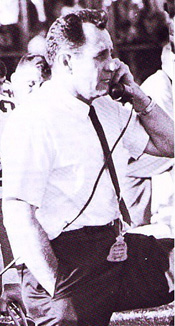
Bill Peterson
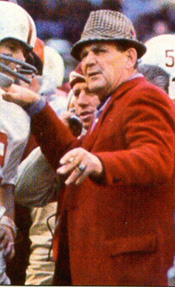
Bear Bryant
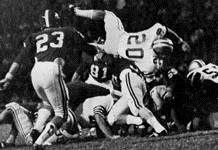
FSU-Alabama action 1967
|
Rock Bottom in Tallahassee
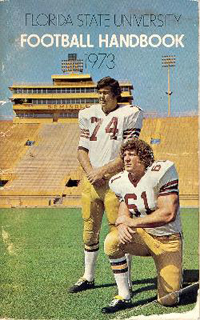 |
Can you believe that Florida State once went 0-11 in football? It was 1973. Head coach Larry Jones (who played and coached at LSU)
was entering his third year after 8-4 and 7-4 records. He decided to get
tougher on the players.
- Before the start of spring drills, Jones violated NCAA rules by ordering players to take a special nine-week PE
class that consisted of grueling (some would say "inhumane")
workouts in "The Room."
- A former dressing area was stripped
of all furniture and chicken wire hung across the room. Players endured
cruel agility drills and bloody one-on-one fights.
- By the end of the session,
28 scholarship players, nearly 1/4 of the team, quit football.
- The result
was a winless season with a depleted roster ending with a 49-0 drubbing
by archrival Florida.
Jones resigned, and FSU was placed
on one year probation. Darrell Mudra was hired to resurrect
the program. However, after 1-10 and 3-8 seasons, he was replaced by Bobby
Bowden, the head coach at West
Virginia. "The rest is history."
|
Florida State University played its first football game in 1947. The team had been put together hurriedly after President Doak Campbell decide to begin football in May at the end of the school's first year after the Florida State College for Women became a coeducational institution.
- P.E. professor Ed Williamson was given the job of finding a head football coach with a Ph.D. Ed quickly learned that the school had set its sights way too high. Finding no suitable candidates, Williamson became the coach in July with the stipulation that it would be for only one year. His "team" at that point had no players, no stadium, no schedule, and no equipment. The school also gave no athletic scholarships.
- Setting the stage for a bitter rivalry, the University of Florida, directly and through its grads in the legislature, sought to block the school in Tallahassee from becoming coed and then, having lost that battle, tried every ploy possible to stop it from playing football. The Board of Control, which oversaw all colleges in the state, voted 3-2 to approve FSU's football program.
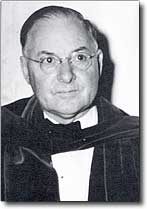 
L-R: FSU President Doak Campbell; Head Coach Ed Williamson, Backfield Coach Jack Haskin
- Williamson had just one assistant coach, Jack Haskin, who was brought in by the new AD, Howard Danford, to start what would become the internationally famous FSU "Flying High" Circus. Haskin would take the backs while Williamson coached the linemen. When Ed asked whether Danford himself could coach football, he was told that his boss's specialties were horseshoes and volleyball.
- Williamson cobbled a schedule in a simple way. He thumbed through an NCAA handbook "to see who had open dates, and I would call them." The first opponent would be Stetson, whose coach, Ben Clemons, had played football at Florida and knew Williamson. Ben offered $300 for FSU to come to Stetson. Ed countered with an offer of $750 to play the game in Tallahassee. Using this approach, he put together a slate of five games with only one on the road.
- Williamson put in a travel request to scout Stetson in its game at Jacksonville. That brought a summons from President Campbell. "Do you mean that you actually want to go over there and spy on this team?" Ed explained that scouting opponents was an accepted part of football.
- With equipment in short supply after the war, the coaches had to go to Tampa, Jacksonville, and Gainesville to get enough. "But we even got garnet and gold uniforms," said Williamson about the colors FSU inherited from the women's college.
- The first practice was held on September 15, 33 days before the opening game. Almost one-fourth of the male enrollment of 500 came out for the team. However, by October 2, attrition had pared the squad to 85, a number that would dwindle even further as the season progressed. Roughly half the squad were military veterans attending college under the GI Bill.
- The team practiced on an old drill field on campus. The field had little grass but lots of sandspurs. A large number of girls lined the field to watch practices. Ken McLean, who had started for Florida in 1944 before entering the military, recalled: "It wasn't uncommon to stop and talk to them while you were doing sprints."
- With no trainers on the staff, student managers tended to injuries as best they could, which usually meant Band-Aids and Mercurochrome.
- 3,000 fans attended the first scrimmage one week before the opener. The team would compete in the game without a nickname since a student vote on the monicker would not take place until a month later.
7,165 showed up for the first football game, a 14-6 loss.
Continued below ...
Reference: Seminoles! The First Forty Years by Bill McGrotha
|
First Football Season – II
The first FSU team opened its 1947 season with a 14-6 loss to Stetson on October 18. Before the next game on November 14, the gridders got a nickname.
- The name would be picked by a vote of the student body.
- A week after the Stetson game, the list of nominations had been narrowed to six: "Golden Falcons," "Statesmen," "Crackers," "Senators," "Indians," and "Seminoles." These survived an intense competition with other suggestions such as "Sandpipers," "Fleas," "Gold Diggers," "Tallywhackers," "Pinheads," and "Tarpons."
- In the final balloting, "Seminoles" won by 110 votes over "Statesmen." One of the football players, Bill Bentz, recalled 40 years later: "I watched every damn ballot that went through, and a whole lot of 'em that didn't have 'Seminoles' on them, I threw away." The team wanted a strong name that no other school could boast.
For the second game, the team made its only road trip of the season, to Lebanon TN to play Cumberland College.
- Coach Williamson picked the first 22 to make the trip. The rest drew straws to fill the remaining 11 travel spots. Williamson recalled: "We got $600 for going up there, and they put us up in this boiler room. ... We slept on cots."
- Rain fell the entire contest. "I remember Bo Manuel kicked a punt, and it hit a pool of water, and just spun around down there in the water," said Williamson. "The field lights ... were not protected, and in the rain they just kept popping out. We had officials that were honest, but not knowledgeable. We had three touchdowns called back." The ball had to be placed carefully after each down to keep it from floating away. Some players claimed that the "crowd" numbered less than a dozen.
- FSU lost five of its 11 fumbles. Cumberland completed just one pass, but it went for the only score of the night: 6-0.
After two competitive games, the fledgling Seminoles returned home to face Tennessee Tech.
- The Golden Eagles, who had defeated Cumberland 42-6, prevailed 27-6 on a muddy field before 5,436.
- FSU gained only five yards rushing.
Troy State came to Tallahassee for a Thanksgiving Day matchup.
- Only 2,942 turned out to watch the Trojans romp 36-6.
- Leonard Melton, a Tallahassean, scored the Seminoles' touchdown on a one-yd plunge following a Jack McMillan INT on the 25.
The season finale took place December 6 against Jacksonville State.
- The 3,700 spectators feared a blowout at the hands of the 8-0 Gamecocks from Alabama.
- Instead, the Hometown Heroes gave up a quick touchdown, then shut down the visitors. The Seminoles drove to the enemy 1, then later to the 6 only to be turned away.
- Jacksonville's undefeated season survived, 7-0.
FSU gained only 687 yards for the season, 400 of which came on 32-of-87 passing. Coaches Williamson and Haskin retired, as agreed upon before the season began. They had planted seeds that would sprout into winning seasons the next four years.
Reference: Seminoles! The First Forty Years by Bill McGrotha
|
"Our team cheated ..., and we still couldn't beat him."
- One of Bowden's opposing coaches was asked, "How good is the legendary FSU coach?"
- The "former college coach, now in the NFL," said: "Our team cheated against Florida State, and we still couldn't beat him. We cheated badly, and that bastard still won."
FSU was "killing teams. They were winning by huge margins and running all kinds of trick plays. They were very intimidating. So we did some things I regret to this day."
- The unnamed coach sent a spy to the Seminole practices. As a result, he learned what FSU planned to run against him, including the trick plays.
- The coach even put microphones in the visitors' locker room. "We heard just about everything before the game and at halftime [that] Florida State was planning. ... We knew probably 30 or 40 percent of what they were going to do ..."
- Yet, the host team still lost. "We had some pretty good players on our team ... Our coaches were cutthroat f***ers with no conscience, but we were good ... We did all that, and he still beat us. I thought after that, 'This is the greatest coach I've ever seen.' Nothing has happened since then to change my mind. No one was better than Bobby, and no one ever will be. ... People don't give Bobby enough credit for being very smart and a great tactical coach."
- And the coach's final word: "I always thought Bobby knew what we did. He probably laughed at us. He probably said to himself, 'Nice dadgum try.'"
It is tempting to try to guess the identity of the anonymous coach who offered the story. In my mind, the culprit is not Steve Spurrier – as much as Seminole fans love to hate him – even though Steve did depart Florida for the NFL.
- First of all, I don't think Steve, the son of a Baptist minister, would use the language quoted by Freeman even in a private conversation.
- And, secondly, the Old Ball Coach had enough talent that he didn't need to cheat. To my recollection, the Gators never incurred NCAA penalties while Spurrier reigned in Gainesville.
Instead, the reference to cutthroat coaches "with no conscience" immediately makes one think of Miami. Of the Hurricane coaches who opposed Bowden, three in a row went to the NFL.
- Jimmy Johnson (1984-88): Jimmy's first game against FSU was a 38-3 loss in the Orange Bowl. J. J. then beat Bobby four years in a row before departing for the Dallas Cowboys.
- Dennis Erickson (1989-94): Like Johnson, Erickson lost his first contest against FSU but in Tallahassee, the only blemish on an 11-1 season. Dennis then won three in a row in the rivalry before falling 28-10 in '93, again in Tallahassee. His final season at Miami produced a 34-20 win. So Erickson had no home losses to Bowden.
- Butch Davis (1995-2000): Suffering from NCAA penalties from the Erickson regime, Davis lost his first five encounters with Bowden before winning the 2000 game 27-24 in the Orange Bowl. Two of the losses were at home, 34-16 in '96 and 26-14 in '98.
So eliminate Erickson and focus on Johnson and Davis.
- Jimmy's only loss to Bowden fits the scenario, but would a team that knew so much of what the opponent was doing lose by 35 points at home?
- So the more likely candidates for the cheating game are Davis's two home losses, one by 18 and one by 12. Trying to rebuild a program on probation might make a coach skirt the rules.
|
|
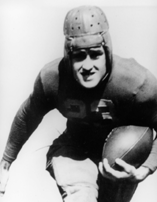
Don Veller at Indiana
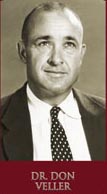
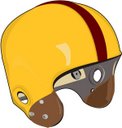
1950 FSU Helmet
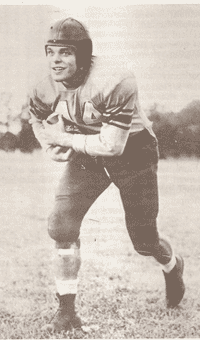
Buddy Strauss
|
Florida State played in its first bowl game in only the third year of its football program.
- Don Veller, a star back at Indiana, became the coach for the second season in 1948.
- In his first season, Veller coached the Seminoles to a 7-1 season with the only loss coming at the hands of the Flying Feet of Erskine College, 14-6, in Due West SC.
- FSU won the Dixie Conference in its first year of existence. The other football-playing members were Stetson, Tampa, Mississippi College, Millsaps, and Howard. The league by-laws prohibited athletic scholarships.
Veller's second season produced an even better result.
- Only a 13-6 loss to Livingston State at Selma AL marred the record. That team was coached by former Alabama All-American C Vaughn Mancha, who would eventually become FSU AD.
- Once again Veller's boys went undefeated in the conference to finish the regular season 8-1. The margin in every victory was at least 19 points except for the 6-0 victory in the fog at Sewanee.
- The 33-14 triumph at Stetson was the first FSU game televised. One station, Jacksonville's WMBR-TV, aired the game. No one at that time could have envisioned a future when it would be a rare Seminole game that was not on TV.
Florida State received an invitation to play in the Cigar Bowl in Tampa on January 2, 1950, against Wofford College of SC.
- The Terriers, winners of 23 straight and ranked higher nationally than schools like Colorado, Maryland, Mississippi State, and Arkansas, were established as two touchdown favorites.
- With no films of the opponent and no chance to scout them in person, Veller prepared a game plan based on statistics culled from the Greenville News. "We noticed that the WB on the team averaged only about 1 yard per carry. So we overshifted defensively to concentrate on the TB."
- More than 2,000 South Carolinians, led by governor Strom Thurmond, joined 12,000 other spectators for the game.
- Seminole FB Buddy Strauss carried 27 times for 131 yd and crashed the backfield from his DE position to help hold Wofford's star TB Sammy Sewell to 1 yard per carry.
- The Terriers took the lead 6-0 several minutes into the game. A 65-yd quick kick by Sewell to the 10 set up a blocked punt for a touchdown. The crowd couldn't be faulted for thinking the rout was on, but nothing could have been further from what happened.
- FSU struck for two touchdowns in Q2. A 55-yd INT return by G Bill Dawkins changed the momentum of the game. A 20-yd drive culminated in a 4-yd sweep to the EZ by Red Parish. Strauss scored the second touchdown on a plunge as the first half gun fired. That score was set up by E Norm Eubanks' sensational catch between two defenders of Parish's left-handed pass to the 2.
- After a scoreless Q3, the Seminoles put the game away with another Parish touchdown with 10 seconds left.
- The statistics showed that the final score of 19-6 was misleading. FSU held the edge in almost every category: 22-6 firsts, 287-106 rushing, 5-11/92 to 2-7/33 passing, and 2-0 fumbles recovered.
- The win was the first bowl victory by any Florida team since 1933 when Miami defeated Manhattan 7-0 in the Palm Festival, the forerunner of the Orange Bowl.
The Cigar Bowl produced a sour aftertaste for the Seminole players (pun intended).
- Promised watches by the bowl officials for playing in the game, they were given cheap miniature rubber footballs instead.
- As a result, FSU players would turn down bowl opportunities the following season when they finished unbeaten.
Reference: Seminoles! The First Forty Years by Bill McGrotha |
A boy named Bobby Bowden had several reasons to forget about playing football.
- Growing up in Birmingham a short distance from Woodlawn High School, Bob watched the high school team practice for hours on end from the roof of his house.
- Little Bobby's infatuation with the sport intensified when the family moved to a larger house just a few hundred yards from the football field at Howard College (now Samford). His father bought him a Howard helmet and uniform.
Yet, as Bobby approached high school age, he faced obstacles to fulfilling his dream.
- The first obstacle was his size. Even as a senior, Bowden was only 5'8" 157 lb.
- When Bobby was 13, he came down with rheumatic fever. He spent most of 1943 either in bed or confined to the house. He passed the time listening to the radio, keeping up with the events of World War II and in the fall listening to the broadcasts of Alabama games. This is also the time when he developed a lifelong love of reading. Doctors told Bobby he would never play sports again.
- When he recovered from his illness – which the family attributed to the power of prayer – he entered Woodlawn but, prohibited from vigorous physical activity because doctors warned that the after effects of the fever could kill him, he took up music.
Bobby's mother finally took him to a cardiologist.
- After running tests on him, the doctor concluded that the boy's heart was enlarged and bore some scar tissue but pronounced him healthy enough to play sports again.
- Bobby tried out for the Woodlawn team. Despite his small size, he impressed Coach Kenny Morgan with his intensity and love of hitting. He was not the least intimidated by larger players.
- Morgan, who became one of the young man's lifelong heroes, played him at QB (blocking back) because Bowden's short stature enabled him to lower his shoulders and get under the pads of the defender.
- Just when Bobby was enjoying being part of the team, he suffered another setback – a badly broken thumb when a pass jammed it. That ended his season.
- But he persevered and became co-captain of the Colonels his senior year. By that point, he had decided that he wanted to be a coach.
- Bobby attended his favorite school in Tuscaloosa but quickly realized that he had no chance in football there. So he transferred to Howard, where he played QB until graduating in 1953. One of his road games was the second game ever played at Doak Campbell Stadium in Tallahassee. He made the Little All-America team as a senior.
Promised an assistant coaching position at Howard if he earned a master's degree, Bowden commuted to Peabody College in Nashville for a year to obtain a master's in PE. He then took the job as assistant coach at his alma mater for an annual salary $3,600.
Continued below ...
Personal note: In preparing this article, I discovered a personal connection with Bobby Bowden.
- My family lived in Birmingham from 1944-46. Dad told me that the first football game I attended was the annual Thanksgiving clash between Woodlawn and Ramsay in 1945 when I was four. Bobby Bowden was a sophomore at Woodlawn and undoubtedly attended the game in the stands if not on the sidelines as a member of the football team.
Reference: Bowden: How Bobby Bowden Forged a Football Dynasty by Mike Freeman
|
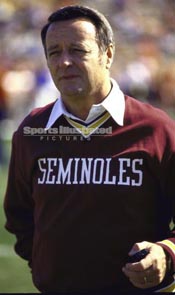 Bobby Bowden
Bobby Bowden |
Bobby Bowden remained an assistant football coach at Howard, his alma mater, for only two seasons. Then a coaching change forced him to leave.
- Initially, he applied and was accepted to Columbia University with the idea of obtaining a doctorate in education.
- One day, he received a note from the president of South Georgia College in Douglas: "If you want to be head coach at South Georgia, phone me collect."
- Bowden did so and still remembers what Dr. William Smith said after learning that Bobby had applied to Columbia: "Son, do you want to coach, or do you want to be a schoolteacher?" Since the answer was obvious, the young Alabamian took the job.
- The 26-year-old father of two would be paid $4,600 a year to be AD and coach not only football but also basketball and baseball. He would also drive the bus for each team.
South Georgia, a two-year college, was even smaller than Howard.
- Bowden realized he would have to raise some money to enhance the school's tiny athletic budget.
- He went door to door in the downtown area asking merchants for donations. At $5 and $10 a pop, he amassed more than $3,000 by the end of the summer.
His first pre-season football practices in 1955 approached Bear Bryant's famous "Junction Boys" camp at Texas A&M.
- The team worked out on a "weed-riddled field where the grass was ankle-high."
- Many of the players were Korean War veterans attending college on the G.I. bill. Despite the fact that many had had more life experience than the coach, they respected him. Not only was respect for authority more prevalent in that era, but Bowden gave good example by his own work ethic.
- Following the conventional wisdom of the time, Bowden allowed no water breaks during the gruelling drills. His goal was to make sure that, even against bigger and faster foes, no team would out-tough his boys.
- A team that had not won a single game the year before won five and the conference title. He was named the league Coach of the Year.
- In four years at South Georgia, Bowden won three state JC championships with tenacity, physicality, and deception. He loved surprising opponents with trick plays which he called "barnyard plays" because anyone running them was like the substance on the barn floor.
In 1959, Bobby returned to Howard as head coach.
- As he had done at South Georgia, he made his first training camp a survival of the fittest. Over the course of seven days, "a lot of guys quit," recalls Bowden, "but the guys who stayed were strong. We had a bunch of tough guys."
- The Bulldogs jumped out to a 5-0 start, holding every opponent scoreless. Finishing 8-1, Howard was invited to the Textile Bowl in Fairfax AL. They defeated Gordon Military College by 5 touchdowns.
- Bowden compiled a record of 31-6 in four years at Howard and oversaw the building of a 6,000-seat stadium.
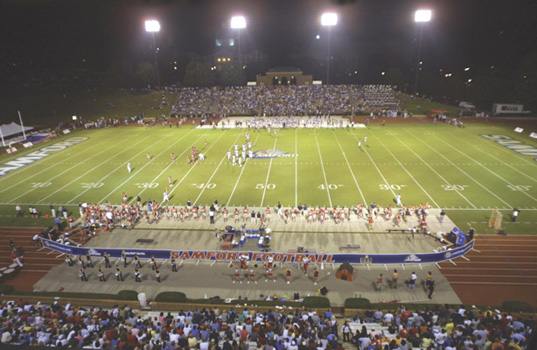
Stadium at Samford University (formerly Howard College)
- During this period, he soaked up as much knowledge as he could from coaches and players. For example, to learn more about the passing game, he phoned Packer QB Bart Starr who lived in the Birmingham area in the off-season. They spent hours diagramming plays on a blackboard.
- Bobby also contacted his idol, Bear Bryant, who let him experience almost every aspect of the Alabama program, mostly through assistant Gene Stallings. Bowden was particularly impressed by the Bear's attention to detail.
- The young coach had become way too good for the level of football played in Howard's conference. His gridders beat one opponent by 12 touchdowns and scored 80 points against another.
Coaches at the highest level of college football noticed his accomplishments.
|

Bobby Bowden with his Howard captains.
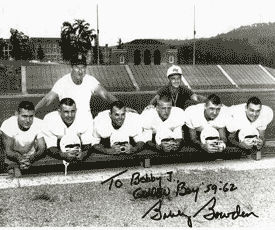
Bowden at Howard |
|
Reference: Bowden: How Bobby Bowden Forged a Football Dynasty by Mike Freeman
|


